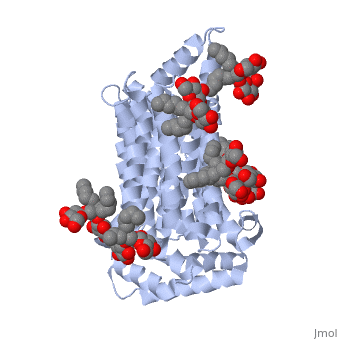Sandbox Reserved 1358
From Proteopedia
(Difference between revisions)
| Line 1: | Line 1: | ||
{{Sandbox_Reserved_HLSC322}}<!-- PLEASE ADD YOUR CONTENT BELOW HERE --> | {{Sandbox_Reserved_HLSC322}}<!-- PLEASE ADD YOUR CONTENT BELOW HERE --> | ||
| - | == | + | ==GLUT3 / SLC2A3== |
<StructureSection load='5c65' size='340' side='right' caption='Structure of DNA' scene=''> | <StructureSection load='5c65' size='340' side='right' caption='Structure of DNA' scene=''> | ||
| - | |||
== Function == | == Function == | ||
| + | The GLUT3 protein, encoded by the SLC2A3 gene in humans, found in mammalian cells, allows for the transport of the glucose molecule across the plasma membrane. It is especially prevalent in the axons of nerve cells in brain tissue. In neurons themselves, GLUT3 is the main glucose transporter that is utilized. In the human body, of the first four glucose transporters discovered (GLUT1, GLUT2, GLUT3, and GLUT4), GLUT3 has a higher glucose affinity and transport capacity, which facilitates its use in glucose transport in neurons. This is significant because the glucose levels surrounding the neuron are five times lower than those found in serum (blood). GLUT3 is also present in sperm, embryos, white blood cells and carcinoma cell lines. | ||
| + | |||
| + | ==Structure== | ||
| + | The GLUT3 transport protein | ||
== Disease == | == Disease == | ||
Revision as of 20:30, 21 February 2018
| This Sandbox is Reserved from January through July 31, 2018 for use in the course HLSC322: Principles of Genetics and Genomics taught by Genevieve Houston-Ludlam at the University of Maryland, College Park, USA. This reservation includes Sandbox Reserved 1311 through Sandbox Reserved 1430. |
To get started:
More help: Help:Editing |
GLUT3 / SLC2A3
| |||||||||||

